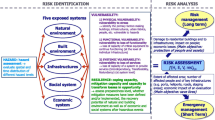Abstract
The term “multi-hazard” is a concept that is increasingly gaining ground in national and international disaster reduction policies. However, its implementation is still timid, and the initiatives that have been carried out are important but insufficient. Multi-hazard scenarios are still difficult to implement due to the complexity of the interactions between the different hazards, the lack of addressed research on this topic, and the uncertainty of their consequences at different spatial and temporal scales. Due to their intrinsic multi-hazard nature and their social, economic, and political context, volcanic islands are particularly vulnerable to these scenarios. These environments require adopting a multi-hazard perspective to design new multi-risk management programmes to reduce risk effectively. The case of the Canary Islands, an active volcanic archipelago that also suffers from multiple non-volcanic geohazards, is a clear example of such complex multi-hazard scenarios. With a worrying overpopulation and tourism that make this management difficult, and with emergency plans that do not consider this multi-hazard perspective, natural disasters may accentuate in the near future. This is also applicable to other volcanic islands in similar situations.
Access this chapter
Tax calculation will be finalised at checkout
Purchases are for personal use only
Similar content being viewed by others
References
Ellingwood, B. R. (2010). Performance-based engineering for multiple hazards: the role of risk assessment. In J. Li, Y. G. Zhao, J. B. Chen, & Y. B. Peng (Eds.), Reliability engineering and risk management, proceedings of the international symposium on reliability engineering and risk management (ISRERM2010). Shanghai: Tongji University Press.
Gill, J. C., & Malamud, B. D. (2016). Hazard interactions and interaction networks (cascades) within multi-hazard methodologies. Earth System Dynamics, 7(3), 659–679. https://doi.org/10.5194/esd-2015-94.
Kappes, M. S. (2011). Multi-hazard risk analyses: a concept and its implementation. Ph.D. thesis, The University of Vienna, Vienna.
Kappes, M. S., Keiler, M., & Glade, T. (2010). From single- to multi-hazard risk analyses: a concept addressing emerging challenges. In Proceedings of the “Mountain Risks” international conference, Firenze.
López-Saavedra, M., Martí, J., Rubio, J.L., & Kelfoun, K. (2021). Cascading effects of extreme geohazards on Tenerife (Canary Islands). Journal of Geophysical Research: Solid Earth 126(9), e2021JB022294. https://doi.org/10.1029/2021JB022294.
UN. (2002). Johannesburg plan of implementation of the world summit on sustainable development. Technical Report, United Nations, Johannesburg. http://www.un.org/esa/sustdev/documents/WSSD_POI_PD/English/WSSD_PlanImpl.pdf.
UN-ISDR. (2015). Sendai framework for Disaster Risk Reduction 2015–2030. In Third United Nations world conference on disaster risk reduction, Sendai, Miyagi, Japan. https://www.undrr.org/publication/sendai-framework-disaster-risk-reduction-2015-2030.
United Nations for Disaster Risk Reduction Homepage. Retrieved January 23, 2022, from https://www.undrr.org/.
United Nations Homepage. Retrieved February 14, 2022, from http://www.un.org/esa/dsd/agenda21/res_agenda21_07.shtml.
Acknowledgements
Marta López-Saavedra received an FPU Ph.D. grant (FPU19/02413). This research was partially funded by the EC Grant EVE (DG ECHO H2020 Ref: 826292).
Author information
Authors and Affiliations
Corresponding author
Editor information
Editors and Affiliations
Rights and permissions
Copyright information
© 2023 The Author(s), under exclusive license to Springer Nature Switzerland AG
About this paper
Cite this paper
López-Saavedra, M., Martí, J. (2023). Multi-Hazard Risk Assessment at the Canary Islands. In: Malheiro, A., Fernandes, F., Chaminé, H.I. (eds) Advances in Natural Hazards and Volcanic Risks: Sha** a Sustainable Future. NATHAZ 2022. Advances in Science, Technology & Innovation. Springer, Cham. https://doi.org/10.1007/978-3-031-25042-2_2
Download citation
DOI: https://doi.org/10.1007/978-3-031-25042-2_2
Published:
Publisher Name: Springer, Cham
Print ISBN: 978-3-031-25041-5
Online ISBN: 978-3-031-25042-2
eBook Packages: Earth and Environmental ScienceEarth and Environmental Science (R0)




